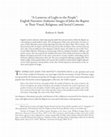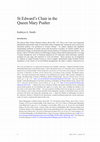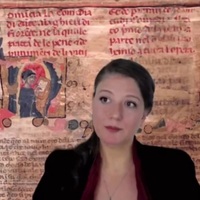Books by Kathryn A Smith

This anthology is the first broadly based exploration of an issue now emerging at the intersectio... more This anthology is the first broadly based exploration of an issue now emerging at the intersection of art history and literary study: how the interplay of images and texts in medieval manuscripts enabled an array of social interactions that helped shape individual and communal experience and identities. An interdisciplinary group of scholars, from Art History, English, and French departments, has combined to explore the ways in which pictures in a book can have a 'social life'. Setting aside the traditional assumption that illuminated manuscripts were meant chiefly for the eyes of solitary reader-viewers, the essays in this anthology demonstrate that illuminations took on social dimension in many ways. They could cue internal dialogues with religious figures or family members; they could be described, explained, and/or viewed communally during public readings; and they could draw their viewers into joint celebration of core secular or religious values. As much as architectural monuments, contracts, and rituals, illuminations provide a way for us to map the multiple dimensions of medieval social life.

Cited: Martha Easton, “Feminist Art History and Medieval Iconography,” in Colum Hourihane, ed., T... more Cited: Martha Easton, “Feminist Art History and Medieval Iconography,” in Colum Hourihane, ed., The Routledge Companion to Medieval Iconography (London and New York: Routledge, 2017), 875n37; “The French of England: Annotated Short Bibliography and Resources,” Fordham University, https://frenchofengland.ace.fordham.edu/?page_id=100#some-art-historical; “Crowned Woman (likely Eleanor of Woodstock) at Mass,” Feminae: Medieval Women and Gender Index, https://inpress.lib.uiowa.edu/feminae/DetailsPage.aspx?Feminae_ID=37792; Kathryn A. Smith, "Margin," in Medieval Art History Today: Critical Terms, ed. Nina Rowe, special issue of Studies in Iconography 33 (2012), 44n34; Nigel Morgan, "English Books of hours, c. 1240-c.1480," in Sandra Hindman and James H. Marrow, ed., Books of Hours Reconsidered (London and Turnhout: Harvey Miller, 2013), 90n26; Kathryn A. Smith, "'Specially English': Gothic Illumination, c. 1190-Early Fourteenth Century," in A Companion to Medieval Art: Romanesque and Gothic in Northern Europe, 2nd, rev. ed. Conrad Rudolph (Hoboken: Wiley-Blackwell, 2019), 585, 591n68, 592n79, n81, 599.
Publicity: Sarah J. Biggs, “The Taymouth Hours,” The British Library Medieval Manuscripts Blog, April 13, 2012,
https://blogs.bl.uk/digitisedmanuscripts/2012/04/the-taymouth-hours.html?_ga=2.119940683.2120474733.1614875499-558522456.161487549
If you would like a complete pdf of my book, please contact me at kathryn.smith@nyu.edu or via Ac... more If you would like a complete pdf of my book, please contact me at kathryn.smith@nyu.edu or via Academia.edu.
The British Library, 2003
Articles, Essays, and Entries by Kathryn A Smith
"Opening the Space of the Parchment Roll: Imaging Interiority in Two English Copies of the 'Septenarium pictum'", 2024
In 'Tributes to Elly Miller: Opening Manuscripts', ed. Stella Panayotova, Lucy Freeman Sandler, a... more In 'Tributes to Elly Miller: Opening Manuscripts', ed. Stella Panayotova, Lucy Freeman Sandler, and Tamar Wang (Turnhout and London: Harvey Miller, 2024), 322-45
First 3 pages only: if you would like a copy of the full essay please contact me directly at Kathryn.smith@nyu.edu

The Medieval Book as Object, Idea and Symbol, ed. Julian Luxford, Proceedings of the 2019 Harlaxton Symposium, Harlaxton Medieval Studies XXXI (Donington: Shaun Tyas), 105-28 + plates , 2021
This essay is intended as a contribution to the scholarly conversation around the signifying powe... more This essay is intended as a contribution to the scholarly conversation around the signifying power of fictive books—that is, images of books in medieval books. I examine representations of books in three fourteenth-century English manuscripts -- a Latin Bible written and illuminated in the 1330s (Dublin, Trinity College Library MS 35 [A.I.2]), a bilingual (Latin and Anglo-Norman French) planned miscellany of devotional and didactic works (Paris, BnF MS fr. 400, c. 1340-c.1350), and the 'Liber benefactorum' of St Albans, originally compiled and illuminated in 1380 (London, BL, Cotton MS Nero D VII). My aim is to suggest how particular details of the format, form, or color of the books depicted in these manuscripts, or the script or text written on their fictive pages, reveal the responsiveness of their makers to the books' larger pictorial or codicological contexts, or to the genre of text in which these images of books appear. Some of the fictive books enrich "portraits" of holy or venerable authors or readers; others serve as props in religious narratives, denote authority or identity, or visualize tenets of Christian doctrine, belief, or ideology; still others inflect and complicate images of pedagogy, conversion, or donation. I am interested not only in the semantic potency of individual images of books, but also in their meaning in relation to other book-images, and in the work that these fictive books do as key elements within larger chains and webs of signification.

Studies in Iconography 42 (2021): 53-94 , 2021
English narrative alabaster reliefs depicting the public life and martyrdom of John the Baptist a... more English narrative alabaster reliefs depicting the public life and martyrdom of John the Baptist are a fascinating yet understudied corpus. The starting point of this essay and its place of return is a series of three fifteenth-century panels depicting Saint John the Baptist Before Herod Antipas, the Burial of Saint John the Baptist, and the Burning of Saint John the Baptist's Bones and the Scattering of his Ashes. Once possibly part of an altarpiece made for export, the reliefs are now in the Victoria and Albert Museum (V&A Inv. nos A.124-1946, A.125-1946, and A.126-1946). Drawing on a broad range of literary, liturgical, homiletic, folkloric, and artistic sources, the essay examines the multifaceted nature of late medieval devotion to John the Baptist, focusing in particular on the saint's connection to women, fertility, and healing, and on the festal, celebratory dimensions of his cult. The essay concludes by offering a reading of the V&A reliefs in light of the popular beliefs and customs that would have informed the English alabaster carvers' lived experience and speculates on the roles of lived experience and memory in the creation and reception of images.
NB: This is the FIRST PAGE ONLY of this article. "Studies in Iconography" is published in hard copy and online via ScholarWorks. If you would like a pdf of this article please contact me at kathryn.smith@nyu.edu.

Gesta 59, no. 2, pp. 91-130, 2020
This essay introduces to a wider audience the manuscript that I call the Welles-Ros Bible (Paris,... more This essay introduces to a wider audience the manuscript that I call the Welles-Ros Bible (Paris, Bibliothèque nationale de France, MS fr. 1), the most complete surviving witness and sole extant illuminated copy of the Anglo-Norman Bible, the earliest full prose vernacular Bible produced in England. I argue that this grand, multilingual manuscript and the vernacular translation preserved in its pages were commissioned c. 1366-c.1370 by the widowed baroness Maud de Ros to serve as a primer, mirror, guide, family archive, and source of spiritual consolation for her son, John, fifth Baron Welles of Welle, Lincolnshire, and other estates. Working under the direction of a Carmelite chaplain, who I believe composed the translation, the secular artists who illuminated the manuscript strove to visualize scripture in a manner that was at once faithful to the vernacular biblical text in all its concrete detail, evocative of its most elevated themes, and relevant to the values and lived experience of its intended reader-viewer. I show how the Bible’s pictorial and heraldic program reframes Christian salvation history as Welles family history. In addition, using as case studies a selection of illustrations for the Old Testament books, I endeavor to reconstruct the main artist’s creative process, and to identify some of the possible contours of the collaboration that produced the Bible’s visual program. This essay contributes to our picture of lay literate and religious aspiration; the history of Bible translation and reception; women’s cultural patronage; artists’ literacy and working methods; and medieval ideas about gender, sexuality, memory, and the emotions in post-Black Death England.
Manuscript Studies, vol. 4, no. 2, 2019
This article also is available online via ProjectMuse at https://muse.jhu.edu/article/738211 and ... more This article also is available online via ProjectMuse at https://muse.jhu.edu/article/738211 and on Penn Scholarly Commons.
In 'Reading and Writing in Medieval England: Essays in Honor of Mary C. Erler' ed. Martin Chase and Maryanne Kowaleski , 2019
If you would like a better-quality pdf of this essay please contact me at kathryn.smith@nyu.edu.
A Companion to Medieval Art, 2nd rev. ed., ed. Conrad Rudolph (Wiley-Blackwell), 2019

Electronic British Library Journal, article 10, 2017
The Queen Mary Psalter (British Library, Royal MS. 2 B. VII), probably made c. 1310-20 for a roya... more The Queen Mary Psalter (British Library, Royal MS. 2 B. VII), probably made c. 1310-20 for a royal recipient, is among the most lavishly illuminated manuscripts produced in late medieval England. This study focuses principally on a single picture in the Psalter’s Old Testament preface showing the prophet Nathan’s reproof of a repentant King David, and it identifies in that picture what is ostensibly the earliest surviving depiction of St Edward’s Chair, now commonly known as the Coronation Chair, made at the end of the thirteenth century on the order of Edward I. The drawing and its Anglo-Norman French caption are examined for the evidence they offer concerning a range of artistic and political issues, among them the chair’s possible use in the coronation of Edward II in 1308. This study then widens its focus to consider the depiction in the preface of a second artifact associated with the coronation rite: the dove-topped rod or virga, held by the Egyptian pharaoh in a scene in the Joseph story. The essay concludes with speculations concerning the messages that these two topical treatments of biblical history might have conveyed to their presumed royal reader-viewer(s) about the nature and limits of royal authority.
Our article explores the bed as an object that projects notions of status, aspiration, decorum, a... more Our article explores the bed as an object that projects notions of status, aspiration, decorum, and morality. We are interested in the economic and symbolic values that accrue to the bed, bedding, and the bedroom in late medieval England, as described in wills and household accounts, and as evoked in literary and artistic imagery. We situate our analysis in relation to literal and represented household beds, those associated with birth and inheritance and also those portrayed in images of death. " Childbed " and " deathbed " are terms that frame the human lifecycle. They also invoke the most important item of furniture in the premodern household.
in Denis Piramus, La Vie seint Edmund le rei, ed. by D. W. Russell, Anglo-Norman Text Society, An... more in Denis Piramus, La Vie seint Edmund le rei, ed. by D. W. Russell, Anglo-Norman Text Society, Annual Texts 71 (Oxford: Anglo-Norman Text Society, 2013-14), 41-64.
in The Social Life of Illumination: Manuscripts, Images, and Communities in the Late Middle Ages,... more in The Social Life of Illumination: Manuscripts, Images, and Communities in the Late Middle Ages, ed. by Joyce Coleman, Mark Cruse and Kathryn A. Smith, Medieval Texts and Cultures of Northern Europe 21 (Turnhout: Brepols, 2013), 121-76.
NB: the publisher of my first book, 'Art, Identity and Devotion in Fourteenth-Century England', is given incorrectly in the bibliography for this essay, and was changed without my authorization in the final stages of publication. The originating publisher of my book was The British Library (London).
Thresholds of Medieval Visual Culture: Liminal Spaces, 2012
in 'Thresholds of Medieval Visual Culture: Liminal Spaces', ed. Elina Gertsman and Jill Stevenson... more in 'Thresholds of Medieval Visual Culture: Liminal Spaces', ed. Elina Gertsman and Jill Stevenson, Boydell Studies in Medieval Art and Architecture (Woodbridge, UK: The Boydell Press, 2012), 44-72











Uploads
Books by Kathryn A Smith
Publicity: Sarah J. Biggs, “The Taymouth Hours,” The British Library Medieval Manuscripts Blog, April 13, 2012,
https://blogs.bl.uk/digitisedmanuscripts/2012/04/the-taymouth-hours.html?_ga=2.119940683.2120474733.1614875499-558522456.161487549
Articles, Essays, and Entries by Kathryn A Smith
First 3 pages only: if you would like a copy of the full essay please contact me directly at Kathryn.smith@nyu.edu
NB: This is the FIRST PAGE ONLY of this article. "Studies in Iconography" is published in hard copy and online via ScholarWorks. If you would like a pdf of this article please contact me at kathryn.smith@nyu.edu.
NB: the publisher of my first book, 'Art, Identity and Devotion in Fourteenth-Century England', is given incorrectly in the bibliography for this essay, and was changed without my authorization in the final stages of publication. The originating publisher of my book was The British Library (London).
Publicity: Sarah J. Biggs, “The Taymouth Hours,” The British Library Medieval Manuscripts Blog, April 13, 2012,
https://blogs.bl.uk/digitisedmanuscripts/2012/04/the-taymouth-hours.html?_ga=2.119940683.2120474733.1614875499-558522456.161487549
First 3 pages only: if you would like a copy of the full essay please contact me directly at Kathryn.smith@nyu.edu
NB: This is the FIRST PAGE ONLY of this article. "Studies in Iconography" is published in hard copy and online via ScholarWorks. If you would like a pdf of this article please contact me at kathryn.smith@nyu.edu.
NB: the publisher of my first book, 'Art, Identity and Devotion in Fourteenth-Century England', is given incorrectly in the bibliography for this essay, and was changed without my authorization in the final stages of publication. The originating publisher of my book was The British Library (London).
**Article of the Month for August 2000, in Feminae: Medieval Women and Gender Index, http://inpress.lib.uiowa.edu/feminae/ArticleOfTheMonthPrevious.aspx#2000**
CrossRef DOI: 10.3202/caa.reviews.2008.116; reprinted in excerpted form in 'The Art History Newsletter' as 'Whither Medieval Art History?'; http://arthistorynewsletter.com/blog/.
Philadelphia Collections, ed. by James R. Tanis and Jenny A. Thompson (Philadelphia: Philadelphia Museum of Art, 2001), 24-43
Contact: Johan Van der Beke at Johan.VanderBeke@brepols.net; or Kathryn A. Smith, New York University, Department of Art History, at kathryn.smith@nyu.edu.
For volumes published in the series or in contract, see the attached list.
Hosted by the American Trust for the British Library, and jointly sponsored with the Early Book Society; the Virginia Fox Stern Center for the History of the Book in the Renaissance, Johns Hopkins University; and with gratitude to the Grolier Club.
Forthcoming in 'Opening Manuscripts: A Tribute to Elly Miller', ed. Stella Panayotova, Lucy Freeman Sandler, and Tamar Wang (Turnhout and London: Harvey Miller)
My talk sheds new light on lay literate and religious aspiration; the history of Bible translation and reception; women’s cultural patronage; artists’ literacy and working methods; medieval ideas about gender, sexuality, health, and memory; and English art, society, and culture after the Black Death. In addition, in illuminating some of the possible contours of the collaboration that fueled the “making” of the Welles-Ros Bible, my talk demonstrates what the methods and concerns of art history can contribute to literary and religious studies.
“My talk brings together my early and more recent research on the manuscript that I call the Welles-Ros Bible (Paris Bibliothèque nationale de France MS fr. 1) — the most complete surviving witness and sole extant illuminated copy of the Anglo-Norman Bible, the “earliest full prose vernacular Bible produced in England” (Russell). Building on the work of biblical and literary scholars, I argue that this grand multilingual manuscript and the revised translation that it contains were produced in the later fourteenth century on the order of one of the matriarchs of the baronial Welles family of Lincolnshire. I discuss the circumstances of the commission and the volume’s functions and intended audience; and show how the Bible’s rich pictorial and heraldic program reframes Christian salvation history as Welles family history. Moreover, the manuscript’s main artist clearly read the scriptural text assiduously, adapting or even rejecting his wide-ranging, trans-regional models in order to visualize for his noble clients both the sense of the vernacular translation and its very words. My talk sheds new light on lay literate and religious aspiration and pedagogy; women’s cultural patronage; artists’ literacy and working methods; the history of bible translation and reception; medieval ideas about gender, sexuality, health, memory, and the emotions; and English art, society, and culture after the Black Death.”
This talk brings together my work from the late 1990s and my more recent research on the manuscript that I call the Welles-Ros Bible (Paris BnF MS fr. 1), the most complete surviving witness and sole extant illuminated copy of the Anglo-Norman Bible, the "earliest full prose vernacular Bible produced in England" (Russell). Building on recent work by biblical and literary scholars, I argue that this grand multilingual manuscript and the revised translation that it contains were produced in the later fourteenth century on the order of one or more matriarchs of the baronial Welles family of Lincolnshire. I discuss the circumstances of the commission and the volume's functions and principal intended reader; and show how the Bible's rich pictorial and heraldic program reframes Christian salvation history as Welles family history. Moreover, the manuscript's main artist clearly read the scriptural text assiduously, adapting or even rejecting his wide-ranging, trans-regional models in order to visualize for his noble audience both the sense of the vernacular translation and its very words. My talk sheds new light on lay literate and religious aspiration and pedagogy; the history of bible translation and reception; women's cultural patronage; artists' literacy and working methods; medieval constructions of gender, sexuality, health, memory, and the emotions; and English art, society, politics, and culture after the Black Death.
Paper given at the 46th Annual St. Louis Conference on Manuscript Studies, Vatican Film Library, St. Louis University, June 18, 2019; The Medieval Book as Object, Idea and Symbol, 36th Annual Harlaxton Medieval Symposium, Harlaxton Manor, UK, July 23, 2019; and in the "Works in Progress" series, Institute of Fine Arts, NYU, November 5, 2020.
This workshop proceeds in three parts. In the first part, I introduce the Welles-Ros Bible as an artifact and set it in the larger contexts of its creation.
Second, using as case studies a selection of illustrations for the Old Testament books, I endeavor to reconstruct the illuminator's responses to the vernacular biblical text, and offer hypotheses regarding the pictorial traditions, models, and habits of thought and visualization that appear to have informed his artistic choices and imagery. The artist's sources include both rare and more widely circulating iconographies originating in English traditions of Latin Bible illustration, cosmological diagrams, continental vernacular historical and biblical works, and erudite allegorical imagery associated with books made for both monastic and elite lay reader-viewers. Keenly attuned to the particularities of the vernacular translation that he and his noble clients had before them, the artist adapted and creatively reformulated his models in order to bring his illustrations in line with the text. In a few instances, the artist appears to have rejected known pictorial tradition altogether, creating images that reinterpret details of the text through the lens of the material culture and natural environment of the baronial manor.
My research not only contributes to our picture of late medieval artisanal literacy and artists' working practices. It also illuminates the points of convergence and interchange between later and late medieval monastic and lay religious and artistic cultures, and suggests that their relationship was far from unidirectional. Finally, it affirms the key role of artists, and of book artisans in general, as synthesizers and transformers of diverse intellectual and artistic traditions, and as collaborators in the transmission of vernacular theology.
In the third part of this workshop, I offer evidence concerning the genesis of the Welles-Ros Bible as an intellectual project. The manuscript preserves a revised, modernized version of the text that was apparently undertaken to make it more accessible to a lay readership. Moreover, BnF fr. 1 is thought by some scholars to have been the very artifact for which this revised version was achieved. The pictorial evidence suggests that one or more of the Welles family matriarchs commissioned the manuscript, and perhaps even the translation preserved in its pages. A compelling case thus can be made for female agency as the "engine" driving a signal chapter in the history of vernacular biblical translation and in the creation of this important work of manuscript art.
4/26/19
2/28/19
NB: An earlier version of this paper was presented at the 52nd International Congress on Medieval Studies, Western Michigan University, Kalamazoo, MI, in the first of two sessions, "In Honor of Richard K. Emmerson: Interdisciplinary Approaches to Medieval Art, Drama, and Literature," held on May 11, 2017.
If you would like further information about this paper, to be published in a forthcoming volume, and which derives from my current book project on BnF fr. 1, please contact me at Kathryn.smith@nyu.edu.
Thursday, May 11, 2017, 52nd International Congress on Medieval Studies, Western Michigan University, Kalamazoo, MI
This flash presentation considers the relationships between the well-known Mass picture and the lesser known Tree of Vices in the Butler Hours, examining how the pictures' interrelated imagery, and the Anglo-Norman verse texts in the latter miniature, might have shaped the religious experience of their Butler beholders. It is suggested that the manuscript was designed in part to train the eyes, mind, conscience, and devout comportment of the future William, 3rd Lord Butler, who was a youth at the time of the volume's original production (early 1340s).
NB: This talk, in expanded form, will be published in the journal "Manuscript Studies," vol. 4, no. 2 (Fall 2019)
The seminar will feature four lectures on topics in medieval studies, one hosted by each institution, to take place during the 2014-15 academic year.
The first lecture in the seminar will take place on Friday, December 5th, from 10:15 AM – 12:00 PM
Beth Williamson, Reader in History of Art in the Department of History of Art, University of Bristol, will speak on
“Representing and Embodying the Virgin in a Trecento Reliquary Tabernacle.”
Location: 3 Washington Square Village, Suite 1M (ground fl.), Conference Rm 104; (entrance on Bleecker St., betw. La Guardia Pl. and Mercer; look for the purple NYU-GTS banner)
The seminar will include three further lectures on February 13th, February 27th, and May 8th, 2015.
For further details, please contact Kathryn Smith, Department of Art History, at Kathryn.smith@nyu.edu.